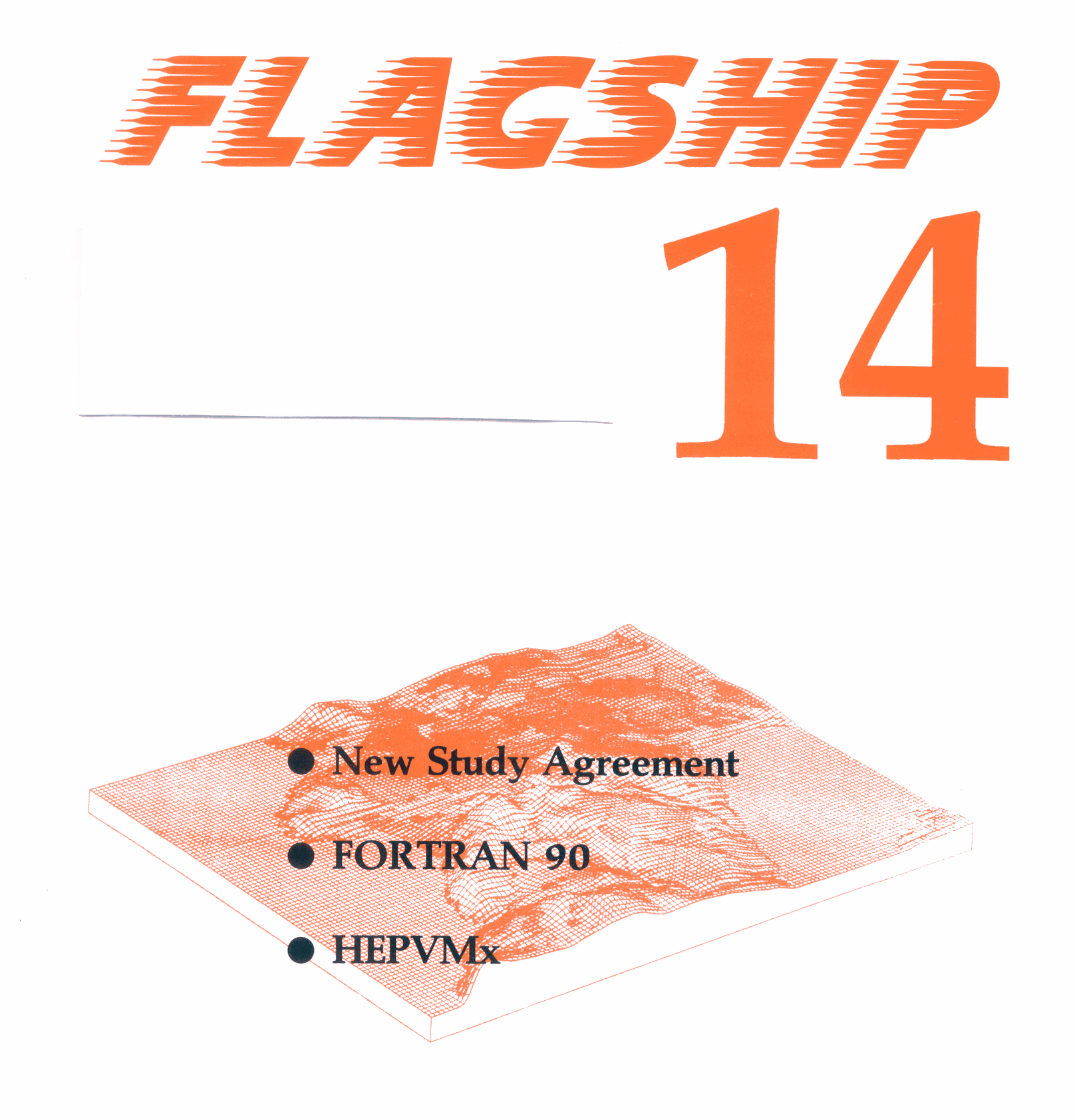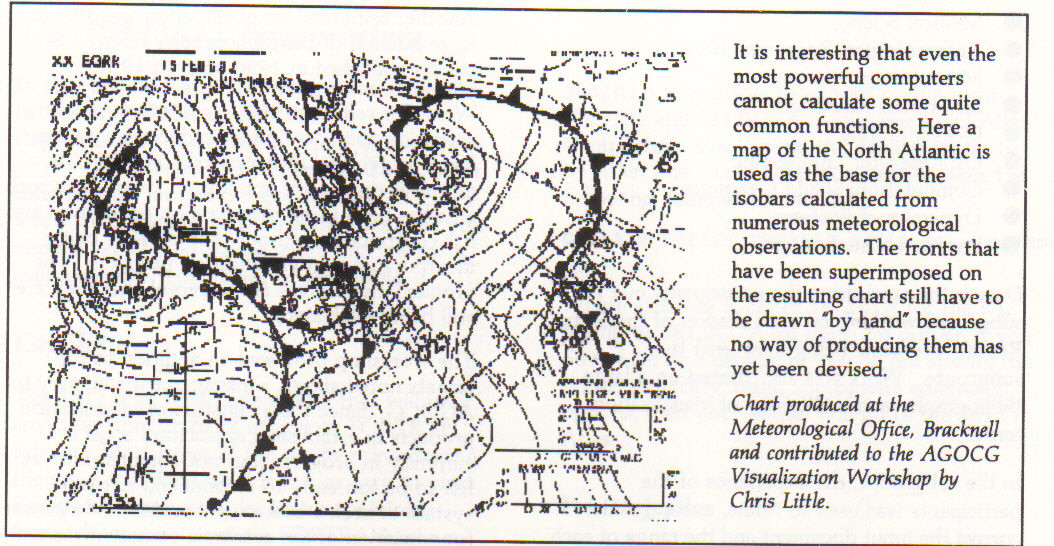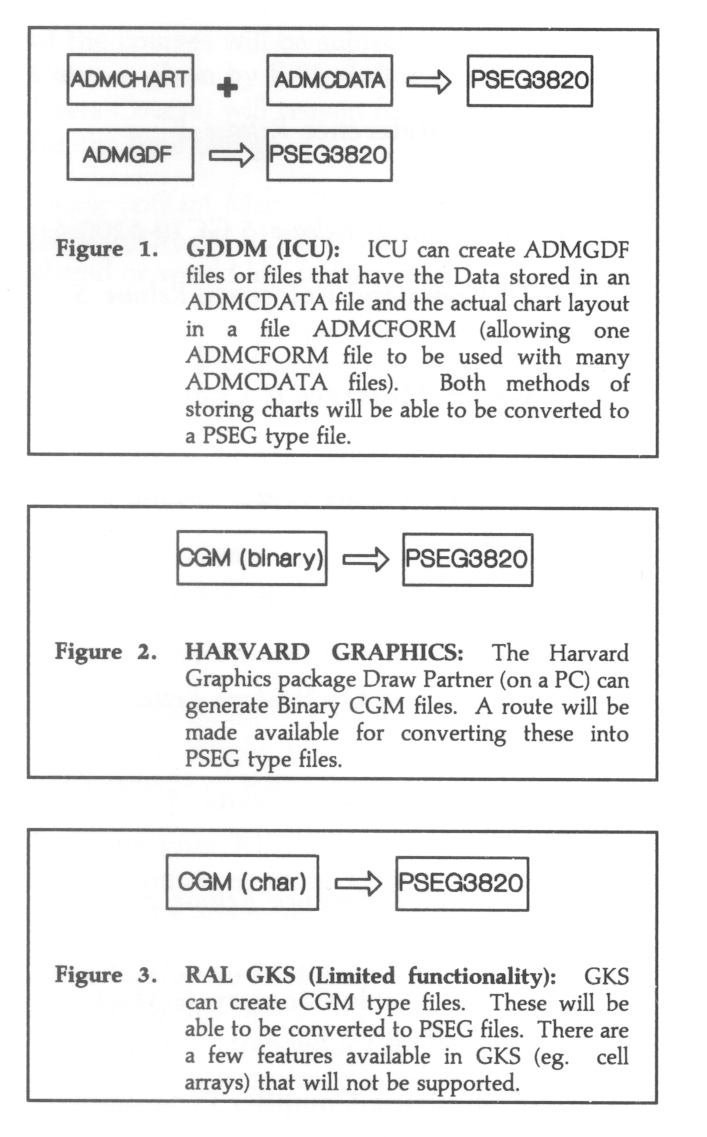


An illustration from the AGOCG Visualisation Workshop. It shows 13 types of landcover superimposed on a vertically exaggerated map.
At the end of May the two-year Joint Study Agreement between IBM and SERC comes successfully to an end; a seminar to mark the occasion was held on May 15 and will be reported in the next issue.
I am pleased to be able to let you know that a large part of the equipment that has been on loan from IBM during the Agreement is about to be purchased by SERC, and that much of the remaining equipment will continue to be available at RAL under the auspices of a new one-year Joint Study which starts in June.
This means that it will be possible to continue meet the current high level of demand for scalar and vector processing on the IBM facility and, through the new Study Agreement, to conduct further studies into advanced computing techniques for science and engineering.
I am delighted to tell you that the new Fortran standard was finalized, down to the last editorial detail, on April 11th. The technical content was completed last year, which is why the name Fortran 90 has been chosen. This corresponds exactly to the situation with Fortran 77, which was completed in 1978.
Fortran 77 was a modest revision of Fortran 66 and the ANSI Committee X3J3 felt under tremendous pressure to add further features such as dynamic storage and array syntax. It therefore went immediately into a "tutorial" mode, learning about experiences in other languages, and aimed to produce a new standard in 1982. In fact, by 1982 most of the new features had been agreed, each as a separate extension, and the task of integrating everything into a new document began. This was when I attended my first meeting, and I became a member of X3J3 at the start of 1983. I expected that the unknown x in the title Fortran 8x would be 8 at most.
The basic reason for the delay was the difference of opinion between those who wished to see a large range of new features and those with more modest goals. A ballot of X3J3 held in April 1986 was 16 to 19 against the draft of that date and led to some slimming down of the language. A second ballot held in January 1987 showed that better agreement had been reached (29-7) and a draft was issued for public comment later that year. Over 400 letters were received, representing varying shades of opinion, some welcoming the power and safety of the new features but many saying that the language was too complex and lacked certain popular extensions. The rules of X3J3 say that at this stage, no change may be made without a two-thirds majority vote. This led to deadlock for two meetings. Finally, in September 1988, the ISO Committee WG5, despairing of ever seeing a standard emerge from X3J3, defined exactly which changes it required and set a timetable for the preparation of a second draft.
Since 1988, progress has been steady, although there have always been about ten no votes for successive versions of the whole language, not enough to prevent acceptance by a two-thirds majority. A second draft was issued for public comment in 1989 and the 150 responses were largely favourable. A third draft in 1990 provoked only twenty-nine letters.
What are the new features? Here is a very brief summary.
The ISO standard will be a replacement for Fortran 77, but within USA, those opposing such a big revision persuaded the parent Committee X3 to make it an additional standard, despite the opposition of X3J3.
The last few years have seen a steady increase in the number of people attending X3J3 meetings, mainly from the vendors. Many of them have been actively working on implementations, but are unwilling to commit themselves to dates for release of compilers. It looks as if NAG's system, written in C to produce a C object code and designed mainly to assist development of their Fortran 90 library, may be the first. It has already been used to check all the examples in my book with Mike Metcalf. Production compilers are likely to appear from 1992 onwards. If you want to have the power and safety of the new features, without the need to rewrite your code in another language, put pressure on a vendor whenever you get a chance.
For four days in February, the topic of Visualization was explored in depth at a workshop sponsored by AGOCG and held at The Cosener's House in Abingdon. Rather than provide another forum for just sharing experience, the organizers of the workshop encouraged synthesis of ideas by making one of the aims of the workshop the publication of a Status Report on Visualization. Despite the lack of time inherent in a "long weekend" format, the kernel of this report was written and has been edited into book form, due to be published by Springer-Verlag this summer under the title "Scientific Visualization - Techniques and Application".
AGOCG (the Advisory Group On Computer Graphics, a body that coordinates aspects of computer graphics for Research Councils, Universities and Polytechnics) had, in 1990, identified Visualization (and more specifically Visualization in Scientific Computing, often abbreviated to ViSQ as an area in which there was no nationwide support. A number of ViSC products were coming onto the market and it was possible that analysis of the strengths and weaknesses of the products would indicate that central purchase through CHEST would benefit the UK academic community. It was decided that a Workshop on Visualization was the only way to determine what was available, what was required and where effort should be targeted.

The original proposers of the workshop (Julian Gallop, RAL Informatics and Chris Osland, RAL Central Computing) suggested that there had been many workshops at which people had presented their visualization problems and solutions and that a working workshop was required if the information required by AGOCG was to be collated. Together with Ken Brodlie (Leeds University), Lesley Carpenter (NAG Ltd.) and Peter Quarendon (IBM Scientific Centre, Winchester), a rough draft document was put together with chapters covering Framework, Techniques, Data Facilities, Applications and Products. This acted as an input document; the suggested aim of the workshop was to refine this into a Status Report (the output document).
To the original five chapters were added an introduction and conclusions (both edited by Rae Earnshaw (Leeds University) and aspects of the Human-Computer Interface were separated into a chapter edited by Roger Hubbold (Manchester University).
Another target was the production of a short Introductory Guide to Visualization that could be widely circulated in the academic community and Rae Earnshaw agreed to prepare this. Finally a scrapbook (in paper and/or video form) of visualization techniques and methods was proposed, since it was felt that many people were confused by the number of techniques available and did not know how to apply them.
The workshop, hosted by Anne Mumford (Loughborough University and Graphics Coordinator), started with some participants describing aspects of their visualization applications and were encouraged to relate this to the framework described in the input document. The wide spread of applications represented at the workshop is obvious from the range of applications covered in the final report:
During the workshop, the participants met in subgroups working on each chapter of the Status Report, everyone being in at least two subgroups. Work was also started on a large Bibliography and a Glossary of visualization terms.
In the subgroups, the experience of the participants was used to refine, expand and correct the input document and the range of each of the chapters. We were fortunate to have Todd Elvins, from the San Diego Supercomputer Centre, as a US-based expert on visualization; his attendance had been sponsored by Eurographics UK and his knowledge of recent developments in the US was most valuable.
With two of the chapters in the report being entitled "Products" and "Applications" , there was interest in which products were used in which applications. The answer was astonishing:
No pure visualization product is currently used by any of the applications studied.
Another semi-random observation was that a large fraction of the bibliography referred to papers published in 1990 or even 1991.
What this reflects is that visualization is a very recent discipline and that products in this area have, as yet, had little penetration into established scientific application areas. Each such area has been using visualization techniques and has contributed methods that are now being incorporated into visualization products. The products themselves are so recent that they are still being evaluated.
The workshop produced, in addition to the targets noted above, a management summary for AGOCG. Since the evaluation of visualization products in established application areas is currently in progress (but not complete) it was felt to be too early to recommend any one system or seek a bulk purchase deal. Manpower for education of the academic community about the capabilities and potential benefits of ViSC systems was requested. The workshop also recommended that visualization products should be made available and evaluated on distributed and parallel architecture systems, since these -together with higher speed networking - were seen as key components in visualization systems of the future.
The full report, in addition to being published as a book, will be distributed to all Research Councils and University Computer Centres; the Introduction to Scientific Visualization will be widely distributed by AGOCG. For further information, please contact the author on 0235-44-6565.
In this article I hope to bring your attention to the capabilities of IBM 3812 Pageprinters. It describes some of the types of file that can be printed on the 3812, with information on how to get started. It gives a few examples of how to print files, but you should see the on-line documentation for a more comprehensive set of examples.
The 3812 is an IBM page printer that will print anything from graphics images to FORTRAN listings. Most types of file can be printed using the same command, so it is just as easy to print a graphics image, or a document containing artwork as it is to print a FORTRAN listing.
There are three commands available to help you get your files printed.
The printer is not a high volume printer, but does provide facilities, new to IBM users, for printing certain types of file. It has a resolution of 240 dots per inch. Those at RAL have very limited operator cover, so it is up to you to keep the paper trays full and to clear paper jams.
There are two printers currently available. One is located in R1 in the room next door to the XER40S0B, and the other is in the Xerox room in the Atlas Centre. They are known to the system as 3812R1A and 3812R27A respectively.
3812R1A is available to all staff on the main RAL site and 3812R27A is available to all Atlas Centre staff. You can set the default printer to be either one. To do this you need to issue the following command from CMS:
GLOBALV SELECT PRT3812 SETLP ON nickname
Where nickname is either 3812R1A for the R1 printer or 3812R27A for the Atlas printer. If you do not set up a default, or you do not specify the printer explicitly, using appropriate command options, then your output will go to the 3812 in Atlas.
The PRT3812 exec determines what processing is required from the filetype of the file being processed and from the options supplied to it. Files with filetypes which are not recognised by the exec as special are, by default, printed in portrait orientation, but you can override any defaults by specifying appropriate options.
Here are some of the special file types recognised by the exec.
PRT3812 PROFILE EXEC
PRT3812 MANUAL MEMO (SCRIPT
PRT3812 DRAWING PSEG3820 (XMITIf you are printing a LIST3820 file with many pictures, this method can be slow. See the on-line the PRT3812 command, issue HELP PRT3812 or FIND PRT3812 from the CMS command line.
It uses a driver that creates a file suitable for printing on a 3812 (a LIST3820 file), then runs the PRT3812 command to send the output to one of the 3812 printers. To get help on this you can type HELP INFO TEX or access the TEX disk by typing GIME TEX and then typing HELP P3812TEX"
P3812TEX MYDOC DVI
XPRINT can be used for printing on the 3812 printers, but it is a rather inflexible method. As you are not able to pass any options of your own to the PRT3812 command (which is invoked by the XPRINT command), the default processing for the particular file type will be used. You can, however, specify the printer you want your output to go to. For more information on using the XPRINT command try HELP XPRINT.
We are investigating a few possible methods for creating suitable graphic images from GDDM type files (eg the ADMGDF files generated by the Interactive Chart Utility (ICU)). Suitable user interfaces to allow the easy conversion of several types of graphic image will be made available in the near future. Figure 1 to Figure 3 show the routes that have been tried so far.

The bar charts showing statistics near the back of this publication were generated with a technique similar to that which will be available in the near future. So you will be able to produce your own publications which include graphic images similar in appearance to this publication on the 3812 Pageprinters!
There is a user's guide that can be requested by contacting MANUALS and asking for the VM3812-IBM 3812 Pageprinter VM Support User's Guide. There are a few differences between the way we run the 3812, and the way the manual suggests. The manual refers to a service machine VM3812; our service machine is called VM3812A. The TUMBLE and DUPLEX options mentioned in the manual are not available on our system.
If you have any questions or problems please contact User Support. You can send Electronic mail to the userid US, or use the ASK US, TELLUS or GRIPE facilities to generate a suitable mail message.